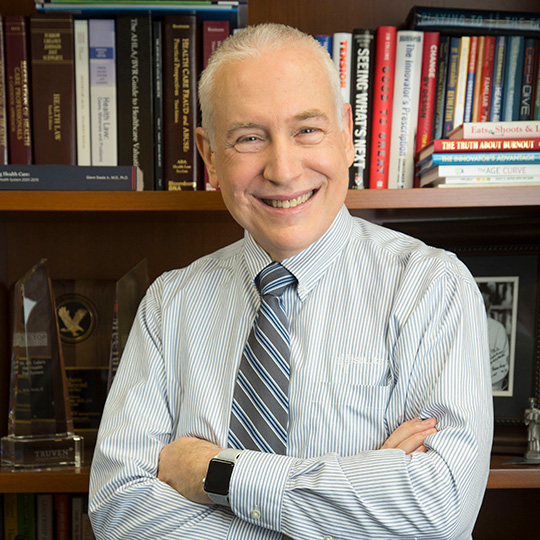Dr. Pate’s Prescription for Change
Medicaid past, present and future in Idaho

Last week, the Idaho Supreme Court affirmed the legality of Medicaid expansion, presented to the state’s voters and approved in November. I thought it might be helpful to take a look at the program’s history and put into context what Medicaid expansion might mean for the people in our communities.
The Medicaid program was signed into law on July 30, 1965, by President Lyndon B. Johnson as part of amendments to the Social Security Act. The program was established to provide medical care, including nursing home care, to low-income pregnant women, children, families and elderly, blind and disabled people.
Medicaid is a federal-state partnership and states have the option to participate. If a state elects to participate (and all states do), then it must administer the Medicaid program and will receive matching funds from the federal government, based upon qualified medical expenditures multiplied by the Federal Medical Assistance Percentage (FMAP).
That percentage is determined for each state based upon the average per capita income relative to the national average and is set as a minimum of 50 percent. For Idaho, the FMAP is about 71 percent, so when an Idahoan on Medicaid incurs $100 of qualified medical services, the state of Idaho must contribute roughly $29 for that care and the balance is paid by the federal government.
A participating state must cover certain people and certain benefits as a requirement of participating in the Medicaid program and can cover more people and more benefits if approved by the federal Centers for Medicare and Medicaid Services (CMS). This is why beneficiaries and benefits vary from state to state.
The Affordable Care Act
In 2010, the Patient Protection and Affordable Care Act, known as the ACA, was passed by Congress and signed into law by President Obama. The law included a requirement that in order to keep their existing Medicaid funding, states had to expand Medicaid coverage to all individuals under the age of 65 with incomes below 133 percent of the federal poverty level in 2014.
In exchange, the federal government would increase the FMAP for this expansion population to 100 percent from 2014 to 2016, but then gradually decrease the matching amount to 90 percent by 2020. The FMAP rate for the existing Medicaid populations would remain the same as before.
A number of states, including Idaho, challenged the constitutionality of the ACA. The Supreme Court ruled that while the ACA was constitutional, the provision mandating expansion of Medicaid was unconstitutional, in that it coerced states to expand their Medicaid programs to retain their existing Medicaid funding. The Court held that state participation in Medicaid expansion must be voluntary.
A part of the ACA that was upheld as constitutional by the Supreme Court was a provision that created insurance subsidies for individuals with household incomes of 100 percent to 400 percent of the federal poverty level. In states that did not expand their Medicaid programs, people who made too much income to qualify for the state’s Medicaid program but not enough to qualify for the insurance subsidies then were left in a “Medicaid gap,” with insurance likely to be unaffordable. In Idaho, that gap was estimated to affect 78,000 residents.
Some states decided either by legislative action or voter initiative to expand their Medicaid programs and in November of 2018, a voter ballot initiative for Idaho to expand its Medicaid program passed and became law.
Court Challenge
The constitutionality of the law then was challenged in the Idaho Supreme Court. The main thrust of the argument was that the law delegated future lawmaking authority regarding Medicaid expansion to the federal government in violation of Article III, section 1 of the Idaho Constitution.
The basis for the argument was that the newly passed law extends Medicaid coverage “in accordance with sections 1902(a)(10)(A)(i)(VII) and 1902(e)(14) of the Social Security Act.” The argument is essentially that because the U.S. Congress could change either of those sections of the Social Security Act, those changes (which could include changes to income requirements for eligibility) and other changes, such as changes to the enhanced FMAP for the expansion population, would be binding on Idaho and in that way have delegated future lawmaking to the federal government.
The Supreme Court ruled that the adoption of those sections of the Social Security Act in the Idaho statute does not include subsequent additions or modifications of the federal statutes unless the Idaho statute does so by express intent (which the Idaho statute does not). The Supreme Court went on to state that if the federal statute was amended to increase the income level for which Medicaid expansion must be afforded, because Medicaid is a cooperative federal-state program, Idaho would have to pass new legislation conforming with the amendment if it wanted to continue offering expanded Medicaid services to everyone up to the new increased level of income.
Further, if the federal government were to lower the enhanced FMAP below 90 percent, Idaho could reconsider its participation in Medicaid expansion because the Medicaid program requires an annual appropriation from the state legislature. Based upon the U.S. Supreme Court precedent, if the federal government ever did decide to lower its contribution for this expanded Medicaid population and Idaho then decided to discontinue Medicaid expansion, the federal government could not threaten Idaho’s matching funds for its non-expanded Medicaid program.
Next Steps
Now that the new law has been upheld as constitutional, the next steps are for the Department of Health and Welfare to submit an amended state plan to CMS and for the state legislature to make an appropriation to fund the 10 percent of medical costs for this expanded Medicaid population, which is anticipated to be roughly $10 million. Medicaid expansion would then take effect on Jan. 1, 2020.
Medicaid expansion should allow these 78,000 Idahoans to access health care. The challenge will be access to physicians, which are already in short supply in Idaho. The hope would be that as these patients are now able to receive primary care services, chronic healthcare conditions can be better managed, avoiding costly complications, and patients will be able to see primary care physicians instead of utilizing costly emergency rooms for non-emergent situations.
As a physician, I have seen the consequences of being uninsured. I have seen patients put off seeing physicians until it is so late that now they have expensive complications, as well as cases in which the patient waited so long that their once-curable condition is no longer curable.
One case that still haunts me today is that of a woman who presented to the emergency room where I was on duty. She complained of chest pain, so she was put to the front of the line, and I was called to evaluate her.
The cause of her pain became immediately apparent. A cancer had eroded through her entire breast and into her chest wall. This was a slow, progressive process that would have been readily apparent to her and painful for quite some time.
I asked her why she had not come in earlier. Her reply was that she did not have insurance.
Her once potentially curable breast cancer was now incurable. I loaded her up with pain medicine, admitted her to the hospital and consulted palliative care.
I don’t want anyone to die needlessly. I am glad the people of Idaho feel the same way.
Dr. Pate joined Gemma Gaudette on Boise State Public Radio's Idaho Matters to discuss the the impact Medicaid expansion could have on community health and the healthcare industry. Listen to the conversation.
About The Author

David C. Pate, M.D., J.D., previously served as president and CEO of St. Luke's Health System, based in Boise, Idaho. Dr. Pate joined the System in 2009 and retired in 2020. He received his medical degree from Baylor College of Medicine in Houston and his law degree from the University of Houston Law Center.

